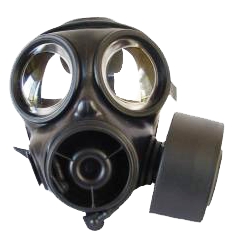 W
WThe FM12 CBRN Respirator is a military gas mask produced by Avon Rubber.
 W
WThe General Service Respirator is a military gas mask designed to replace the previous S10 respirator for the British Armed Forces. It was designed by DSTL and Scott Safety in collaboration with the MoD, and was manufactured by Scott Safety. Avon Protection now manufacture the GSR from their factory in Melksham after winning the in-service support contract in 2019.
 W
WThe Hypo helmet, or British Smoke Hood, was an early British World War I gas mask, designed by Cluny MacPherson.
 W
WThe P helmet, PH helmet and PHG helmet were early types of gas mask issued by the British Army in the First World War, to protect troops against chlorine, phosgene and tear gases. Rather than having a separate filter for removing the toxic chemicals, they consisted of a gas-permeable hood worn over the head which was treated with chemicals.
 W
WThe Service Respirator No. 6 (S6), also known as Respirator NBC S6 No. 1 Mark 1 was a protective gas mask issued to the British Armed Forces. It was developed in the 1950s and issued for general service from 1966 to 1986, when it was replaced by the S10. Currently, the S6 is not used by the British military.
 W
WThe S10 CBRN Respirator is a military gas mask that was formerly used within all branches of the British Armed Forces. Following the mask's replacement by the General Service Respirator in 2011, the S10 is now widely available to the public on the army surplus market.
 W
WThe small box respirator was the initial compact version of the recent gas mask. In late 1916, the respirator was introduced by the British with the purpose to provide reliable protection against chlorine and phosgene gas. The respirator offered a first line of defense against the gas. A later and more toxic gas, Mustard Gas, was created by Germans and was a vesicant that burnt the skin of individuals that were exposed to it. Death rates were high with exposure to both the mixed phosgene chlorine and mustard gas, however with soldiers having readily available access to the small box respirator, death rates had lowered significantly. Light and reasonably fitting, the respirator was a key piece of equipment to readily protect the respiratory health of soldiers on the battlefield.